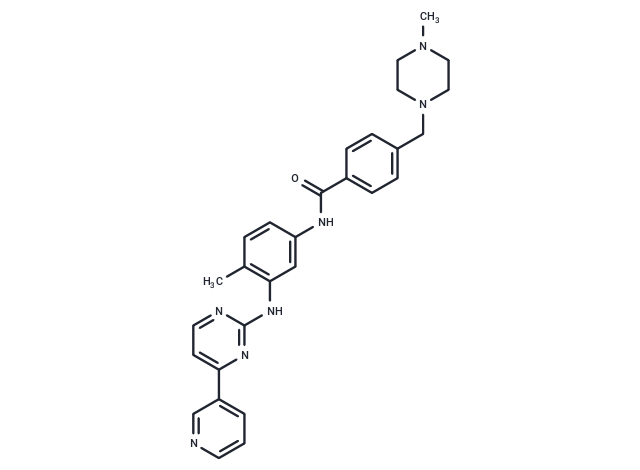Shopping Cart
- Remove All
 Your shopping cart is currently empty
Your shopping cart is currently empty

Imatinib (STI571) is a multi-targeted receptor tyrosine kinase inhibitor that selectively inhibits the kinase activities of BCR/ABL, v-Abl, PDGFR, and c-kit with oral activity. Imatinib has antitumor activity for the treatment of chronic granulocytic leukemia.

| Pack Size | Price | Availability | Quantity |
|---|---|---|---|
| 100 mg | $36 | In Stock | |
| 200 mg | $52 | In Stock | |
| 500 mg | $79 | In Stock | |
| 1 g | $118 | In Stock | |
| 5 g | $209 | In Stock | |
| 1 mL x 10 mM (in DMSO) | $57 | In Stock |
| Description | Imatinib (STI571) is a multi-targeted receptor tyrosine kinase inhibitor that selectively inhibits the kinase activities of BCR/ABL, v-Abl, PDGFR, and c-kit with oral activity. Imatinib has antitumor activity for the treatment of chronic granulocytic leukemia. |
| Targets&IC50 | c-Kit:100 nM (cell free), PDGFR:100 nM (cell free) |
| In vitro | METHODS: Human, mouse and rat osteosarcoma cells were treated with Imatinib (1-40 μM) for 72 h, and cell viability was measured using XTT assay. RESULTS: Imatinib reduced the number of live osteosarcoma cells in a dose-dependent manner, with 72 h IC50s of 20 μM (MG-63), 11 μM (HOS), 23 μM (MOS-J), 15 μM (POS-1), and 9 μM (OSRGA). [1] METHODS: Human gastric cancer cells AGS, MKN45 and SNU638 were treated with Imatinib (30-100 μM) for 48 h. Apoptosis was detected using Flow Cytometry. RESULTS: The percentage of Annexin V/PI-positive cells was significantly increased, indicating that Imatinib treatment increased early apoptosis of tumor cells. [2] |
| In vivo | METHODS: To investigate antitumor activity, Imatinib (25-100 mg/kg) was administered orally to mice bearing undifferentiated POS-1 or mixed osteoblast/osteolytic MOS-J osteosarcoma tumors once daily for 21 or 43 days. RESULTS: Imatinib inhibited osteosarcoma progression in vivo. [1] METHODS: To study the effects on multiple sclerosis (MS), Imatinib (60 mg/kg) was administered orally six times per week for two weeks to an EAE C57BL/6 mouse model. RESULTS: Imatinib had beneficial effects on EAE by reducing disease severity and delaying onset.Imatinib and its potential therapeutic effects and immunomodulatory properties may be considered for the treatment of multiple sclerosis. [3] |
| Cell Research | M-07e cells were grown in serum-free RPMI 1640 at 37°C for approximately 18 hours before they were incubated for 90 minutes in the presence of various concentrations of STI 571. The cells were then pelleted and resuspended in 1 mL RPMI 1640. STI 571 was added to each tube to achieve the same concentration used during the 90 minutes of preincubation. The cells were then incubated with inhibitor and growth factor (SLF or GM-CSF) for 15 minutes at 37°C. Subsequently, the cell pellets were lysed with 100 to 250 μL of protein lysis buffer (50 mmol/L Tris, 150 mmol/L sodium chloride, 1% NP-40, and 0.25% deoxycholate, with addition of the inhibitors aprotinin, leupeptin, pepstatin, phenylmethyl sulfonyl fluoride, and sodium orthovanadate). Western immunoblot analysis was performed as previously described.41Experiments with HMC-1 cells were performed in the same way except that neither SLF nor GM-CSF was added [1]. |
| Animal Research | Swiss mice (nu/nu, female), weighing 30 g, 6 – 8 weeks old, were bred in the animal facilities, maintained under specific pathogen-free conditions with artificial lighting (12 hr light/12 hr dark cycle) and fed a regular diet and water ad libitum. For therapeutic trials, the tumor-bearing mice were randomly divided into equivalent groups of 5 to 12 animals and mice were treated as soon as the xenografted tumors reached a diameter of 5 mm (or a tumor volume of approximately 60 mm^3). Four different human tumors were used: the SCLC6, SCLC61, SCLC 74 and SCLC108 small cell lung cancers. STI571 was administered at a total dosage of 70 or 100 mg/kg per day in 1 or 2 intraperitoneal injections, with or without etoposide plus ifosfamide or topotecan. STI571 was diluted in 150 l of H2O and administered on different days, as indicated. Etoposide and ifosfamide were diluted in 200 l of 0.9% sodium chloride, and topotecan was diluted in 150 l of 0.9% sodium chloride. The control group received injections according to the same schedule as experimentally treated mice. All mice were weighed once weekly. Tumor growth was monitored by measuring 2 perpendicular diameters with calipers. Tumor volume (V) and the relative tumor volume (RTV) were calculated as:. V = a^2 × b/2,. where a is the width (large diameter) and b the length (small. diameter) of the tumor in millimeters, and. RTV = Vx/Vi,. where Vx is the mean tumor volume in cubic millimeters at any given time and Vi is the mean initial tumor volume in cubic millimeters at the start of treatment. Mice were ethically sacrificed when the tumor volume reached 2,500 mm^3 [5]. |
| Alias | STI571, ST-1571, CGP057148B |
| Molecular Weight | 493.6 |
| Formula | C29H31N7O |
| Cas No. | 152459-95-5 |
| Smiles | CN1CCN(CC2=CC=C(C=C2)C(=O)NC2=CC(NC3=NC(=CC=N3)C3=CC=CN=C3)=C(C)C=C2)CC1 |
| Relative Density. | 1.255g/cm3 |
| Storage | store at low temperature | Powder: -20°C for 3 years | In solvent: -80°C for 1 year | Shipping with blue ice. | ||||||||||||||||||||
| Solubility Information | 10% DMSO+40% PEG300+5% Tween 80+45% Saline: 2.5 mg/mL (5.06 mM), In vivo: Please add the solvents sequentially, clarifying the solution as much as possible before adding the next one. Dissolve by heating and/or sonication if necessary. Working solution is recommended to be prepared and used immediately. DMSO: 25 mg/mL (50.65 mM), Sonication is recommended. | ||||||||||||||||||||
Solution Preparation Table | |||||||||||||||||||||
DMSO
| |||||||||||||||||||||

Copyright © 2015-2025 TargetMol Chemicals Inc. All Rights Reserved.